Content is from Kirkbride et al. 2006Kirkbride et al. 2006:
Kirkbride JH, Jr, Gunn CR, and Dallwitz MJ. 2006. Family guide for fruits and seeds, vers. 1.0. Accessed September 2020-January 2022. URL: https://nt.ars-grin.gov/seedsfruits/keys/frsdfam/index.cfm ., without modification.
Updates are forthcoming.
Fruits: Pistil(s) compound; with carpels united. Fruit pericarpium; simple; capsulecapsule:
a dry, dehiscent fruit derived from a compound ovary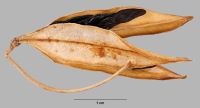 (not Spjut), or drupedrupe:
(not Spjut), or drupedrupe:
(indehiscent drupe) a fleshy, indehiscent fruit with one more hard pits enclosing seeds, derived from single, superior, simple or compound ovary; (dehiscent drupe) a fruit with a dry or fibrous to fleshy or leathery outer husk that early to tardily breaks apart (or opens), exposing one or more nutlike pits enclosing the seeds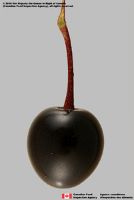 (Parastyrax); loculicidalloculicidal:
(Parastyrax); loculicidalloculicidal:
type of capsular dehiscence, opening longitudinally through the locules (compare septicidal)
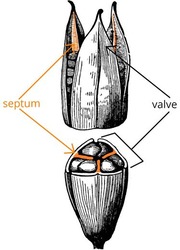 capsulecapsule:
capsulecapsule:
a dry, dehiscent fruit derived from a compound ovary ; capsulecapsule:
; capsulecapsule:
a dry, dehiscent fruit derived from a compound ovary not inflated; capsulecapsule:
not inflated; capsulecapsule:
a dry, dehiscent fruit derived from a compound ovary without operculumoperculum:
without operculumoperculum:
a dehiscent cap (or lid) of a seed or fruit that opens during germination or dehiscence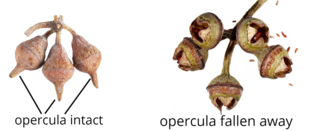 ; without persistent central column; within accessory organ(s); within calyxcalyx:
; without persistent central column; within accessory organ(s); within calyxcalyx:
the outer whorl of the perianth; all the sepals of a flower ; 1-seeded to many-seeded (rarely); 1-seeded (to many in Huodendron, Alniphyllum); from 1–5 cm long; 1 cm long (at least); with (2–)5-carpellate ((2-)3–5); with carpels united; with carpels remaining united at maturity; with carpels radiating at maturity; with carpels remaining connected at stylestyle:
; 1-seeded to many-seeded (rarely); 1-seeded (to many in Huodendron, Alniphyllum); from 1–5 cm long; 1 cm long (at least); with (2–)5-carpellate ((2-)3–5); with carpels united; with carpels remaining united at maturity; with carpels radiating at maturity; with carpels remaining connected at stylestyle:
in a flower, the narrow and elongated part of the pistil between the stigma and the ovary; sometimes persisting in fruit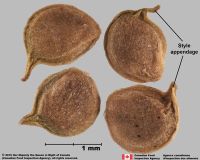 ; without sterilesterile:
; without sterilesterile:
lacking male and/or female reproductive parts; also, not producing fruit or seed
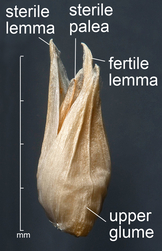 carpels; not sulcatesulcate:
carpels; not sulcatesulcate:
surface relief—having one or more elongate, relatively narrow and shallow depressions or grooves ; apexapex:
; apexapex:
the point farthest from the point of attachment, or the "tip" of an organ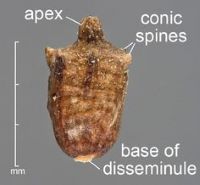 not beakedbeak:
not beakedbeak:
a usually firm, terminal appendage, sometimes tapered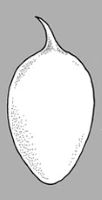 , or beaked; apexapex:
, or beaked; apexapex:
the point farthest from the point of attachment, or the "tip" of an organ long beakedbeak:
long beakedbeak:
a usually firm, terminal appendage, sometimes tapered to short beaked; indehiscentindehiscent:
to short beaked; indehiscentindehiscent:
not opening on its own, as in a fruit
 , or dehiscentdehiscent:
, or dehiscentdehiscent:
(v. dehisce) splitting open at maturity to release contents (of a fruit)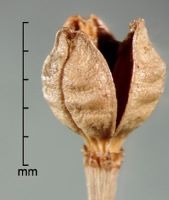 . Dehiscentdehiscent:
. Dehiscentdehiscent:
(v. dehisce) splitting open at maturity to release contents (of a fruit) unit seed(s). Dehiscentdehiscent:
unit seed(s). Dehiscentdehiscent:
(v. dehisce) splitting open at maturity to release contents (of a fruit) and shedding seeds; without replumreplum:
and shedding seeds; without replumreplum:
the rim, formed by the persistent placentas, and connected by a false septum in Brassicaceae fruits. The fruit valves are attached to this rim and separate from it in dehiscent fruits. . Epicarpepicarp:
. Epicarpepicarp:
outer layer of fruit wall or pericarp, if divided into layers; note here used synonymously with exocarp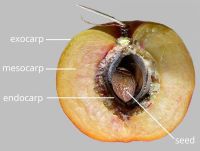 brown (all shades), or gray; durable; glabrousglabrous:
brown (all shades), or gray; durable; glabrousglabrous:
without hairs
, or not glabrousglabrous:
without hairs
(with hairs); hairs short, or long; hairs scattered (various pubescences including stellatestellate:
star-shaped; with radiating branches ); hairs yellow to brown; hairs not glandularglandular:
); hairs yellow to brown; hairs not glandularglandular:
surface relief—covered with small, raised secretory glands, regular or irregularly shaped, translucent or opaque, and maybe distinctly colored ; without armature; not smooth; punctatepunctate:
; without armature; not smooth; punctatepunctate:
surface relief - dotted with pits or with translucent, sunken glands or with colored dots, similar to pitted ; without wing(s), or with wing(s); 2–4-winged; with wing(s) laterallateral:
; without wing(s), or with wing(s); 2–4-winged; with wing(s) laterallateral:
(of embryo) embryo lies along the side of the seed, generally towards one end; of, at, or from the side; in grasses, can refer to the sides adjacent to the dorsal and ventral sides
; without apicalapical:
at or pertaining to the end of the seed or fruit distal from its point of attachment (i.e., base)
respiratory hole. Mesocarpmesocarp:
the middle layer of the pericarp, if divided into layers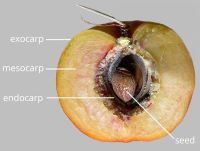 absent, or present. Endocarpendocarp:
absent, or present. Endocarpendocarp:
the inner layer of the pericarp, if divided into layers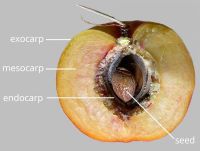 present; not separating from exocarpexocarp:
present; not separating from exocarpexocarp:
outer layer of fruit wall or pericarp, if divided into layers; note here used synonymously with epicarp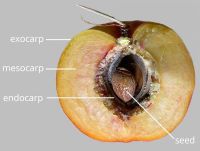 ; woodywoody:
; woodywoody:
texture—consisting mainly of indurate lignified tissues, characteristic of or resembling wood
, or thin; not splitting into 1-seeded pyrenes; without wing; without operculumoperculum:
a dehiscent cap (or lid) of a seed or fruit that opens during germination or dehiscence ; without secretory cavities; without mechanism for seedling escape; without longitudinallongitudinal:
; without secretory cavities; without mechanism for seedling escape; without longitudinallongitudinal:
of or relating to length or the lengthwise dimension
ridges. Funiculusfuniculus:
(alt. funicle) stalk connecting the ovule (later seed) to the ovary (later fruit) placenta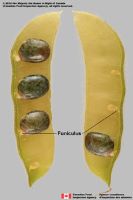 short; short without seed bearing hookswith hooks:
short; short without seed bearing hookswith hooks:
bristles or spines with curved or backwards pointing tips, or with secondary bristles along their length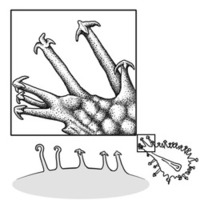 (retinacula); not persisting in fruit after seed shed.
(retinacula); not persisting in fruit after seed shed.
Seeds: Arilaril:
(broad sense) appendicular structure that wholly or partly envelops a seed and is produced from or a modification of the funicle, raphe, or outer integument; usually fleshy or pulpy, sometimes spongy or tufted-capillate, often brightly colored absent. Seed larger than minute; 1 to less than 5 mm long to 50+ mm long; 5–50 mm long; circularcircular:
absent. Seed larger than minute; 1 to less than 5 mm long to 50+ mm long; 5–50 mm long; circularcircular:
(of embryo) linear embryo is curved into an "O" shape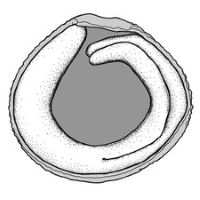 , or linearlinear:
, or linearlinear:
(shape) long, narrow, and uniform in width; (of embryo) embryo is straight and much longer than wide , or oblongoblong:
, or oblongoblong:
2D shape—much longer than broad with nearly parallel sides, corners are rounded , or ovateovate:
, or ovateovate:
2D shape—egg-shaped in outline, widest point is towards one end of the organ, the other end tapers gradually, attachment at or near the broad end (compare obovate, ovoid)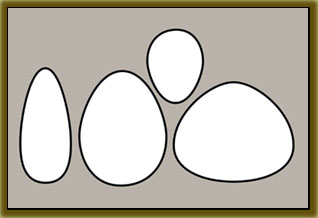 ; not bowl shaped; not nutlike; without winglike beakbeak:
; not bowl shaped; not nutlike; without winglike beakbeak:
a usually firm, terminal appendage, sometimes tapered ; without caudatecaudate:
; without caudatecaudate:
tapering to a long, tail-like appendage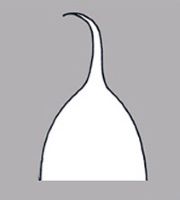 appendage(s); at maturity with food reserves; with endosperm; without canavanine. Sarcotestasarcotesta:
appendage(s); at maturity with food reserves; with endosperm; without canavanine. Sarcotestasarcotesta:
pulpy or fleshy outer layer of the seed coat, simulates aril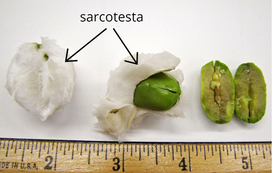 absent. Testatesta:
absent. Testatesta:
seed coat
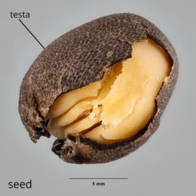 present; without markedly different marginalmarginal:
present; without markedly different marginalmarginal:
at, on, or close to the margin or border
tissue, or with markedly different marginalmarginal:
at, on, or close to the margin or border
tissue; marginalmarginal:
at, on, or close to the margin or border
tissue winglike; without fleshy or leatheryleathery:
texture—moderately thick, tough, and very pliable
layer over hard layer; loose; dulldull:
reflecting only a low proportion of incident light, with no apparent sheen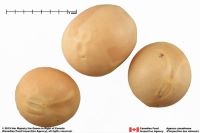 ; surface unsmooth, or smooth; surface with depressed features, or discreet raised features, or merged raised features; surface groovedgrooved:
; surface unsmooth, or smooth; surface with depressed features, or discreet raised features, or merged raised features; surface groovedgrooved:
surface relief—linear depressions that may be single or form a series of grooves over the surface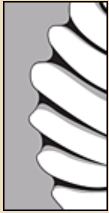 ; surface papillatepapillate:
; surface papillatepapillate:
surface relief—bearing minute, distinct, broad-based projections, tapering to a rounded apex ; surface wrinkledwrinkled:
; surface wrinkledwrinkled:
surface relief—shallow, irregular folds and furrows covering the surface; appearing overall though crumpled and then spread out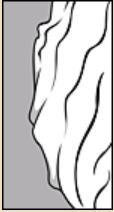 ; without glands; without bristles; glabrousglabrous:
; without glands; without bristles; glabrousglabrous:
without hairs
, or pubescent (stellatestellate:
star-shaped; with radiating branches ); without glandularglandular:
); without glandularglandular:
surface relief—covered with small, raised secretory glands, regular or irregularly shaped, translucent or opaque, and maybe distinctly colored pubescence; without wings, or with wing(s); without collar; without operculumoperculum:
pubescence; without wings, or with wing(s); without collar; without operculumoperculum:
a dehiscent cap (or lid) of a seed or fruit that opens during germination or dehiscence ; colored; monochrome; brown (all shades), or orange, or red (letter two in combination with brown); crustaceouscrustaceous:
; colored; monochrome; brown (all shades), or orange, or red (letter two in combination with brown); crustaceouscrustaceous:
texture—thin, dry, indurate, and brittle
, or thin; not becoming mucilaginousmucilaginous:
resembling mucilage; moist and sticky
when wetted; surrounding food reserve. Hilumhilum:
on seeds, the scar indicating where the funiculus was attached; on grass caryopses, the scar visible on the outer fruit surface revealing where the seed is attached on the inner fruit wall surface; or in Asteraceae cypselae, the scar visible on the outer fruit wall revealing where the fruit was attached to the receptacle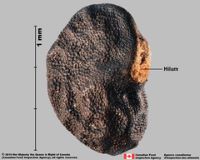 larger than punctatepunctate:
larger than punctatepunctate:
surface relief - dotted with pits or with translucent, sunken glands or with colored dots, similar to pitted . Endosperm development cellular; copious; hard, or fleshy; smooth; with oils; without fatty acid containing cyclopropene; without apicalapical:
. Endosperm development cellular; copious; hard, or fleshy; smooth; with oils; without fatty acid containing cyclopropene; without apicalapical:
at or pertaining to the end of the seed or fruit distal from its point of attachment (i.e., base)
lobes; without chlorophyll; without isodiametric faceted surface; without odor. Embryo differentiated from food reserve; well developed; 1 per seed; partially filling testatesta:
seed coat
 (with food reserve); chamber central to wings; 0.8 times the length of food reserve; at one end of seed not extending into a depression or cup; axileaxile:
(with food reserve); chamber central to wings; 0.8 times the length of food reserve; at one end of seed not extending into a depression or cup; axileaxile:
on or of the axis
and centric; foliatefoliate:
appearing leaf-like
, or conicalconical:
3D shape—cone-shaped, with the point of attachment at the broad end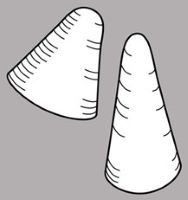 ; with investinginvesting:
; with investinginvesting:
(of embryo) embryo is nearly or completely filling seed coat, straight, and axile and centric with spatulate cotyledons and covering the stalk for at least half its length; (of cotyledons) cotyledons spatulate and covering the stalk for at least half its length
cotyledons, or spatulatespatulate:
2D shape—like a spatula; rounded at the apex, with base long and tapered; (of embryo) embryo is straight and axile and centric with the cotyledons expanded to form the shape of a spatula or spoon; (of cotyledons) cotyledons expanded and wider than the stalk but not invested into the stalk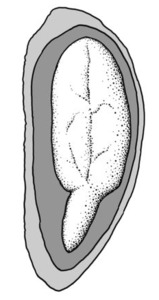 cotyledons; straight, or C-shapedC-shaped:
cotyledons; straight, or C-shapedC-shaped:
2D-shape—semiannulate, curved into the shape of the letter 'C'
; parallel to seed length; embedded in endosperm; with cotyledons abruptly connected to hypocotyl-radicle, or gradually connected to hypocotyl-radicle; without coleorhiza; without simmondsin; without stomata; not green; with 2 or more cotyledons. Cotyledons 2; well developed; (0.2–)0.8 times length of embryo ((0.2-)0.5–0.8); as wide as hypocotyl-radicle, or somewhat to significantly wider than hypocotyl-radicle; 1–2.5 times wider than hypocotyl-radicle; not concealing hypocotyl-radicle; foliaceous, or not foliaceous; thin; flat; smooth; with apicesapex:
the point farthest from the point of attachment, or the "tip" of an organ entire; with margins separate; basally entire; equal in size; not punctatepunctate:
entire; with margins separate; basally entire; equal in size; not punctatepunctate:
surface relief - dotted with pits or with translucent, sunken glands or with colored dots, similar to pitted dotted. Hypocotyl-radicle well developed, or moderately developed; straight; not thickened.
dotted. Hypocotyl-radicle well developed, or moderately developed; straight; not thickened.
Literature specific to this family: Spongberg, S.A. 1976. Styracaceae hardy in temperate North America. J. Arnold Arbor. 59(1):54–73.
General references: Cronquist, A. 1981. An integrated system of classification of flowering plants, 1,262 p. Columbia University Press, New York, Engler, A. & K. Prantl. 1924 and onward. Die Natürlichen Pflanzenfamilimien. W. Engelman, Leipzig, Gaertner, J. 1788–1805. De fructibus et seminibus plantarum. The Author, Stuttgart, Goldberg, A. 1986 (dicots) & 1989 (monocots). Classification, evolution, and phylogeny of the familes of Dicotyledons. Smithsonian Contr. Bot. 58 for dicots (314 pp.) & 71 for monocots (74 pp.). [Goldberg's illustrations are reproduced from older publications and these should be consulted], Gunn, C.R., J.H. Wiersema, C.A. Ritchie, & J.H. Kirkbride, Jr. 1992 & amendments. Families and genera of Spermatophytes recognized by the Agricultural Research Service. Techn. Bull. U.S.D.A. 1796:1–500, Mabberley, D.J. 1987. The plant-book, 706 p. Cambridge University Press, Cambridge, Martin, A.C. 1946. The comparative internal morphology of seeds. Amer. Midl. Naturalist 36:513–660, Schopmeyer, C.S. 1974. Seeds of Woody plants in the United States. Agric. Handb. 450:1–883, and Spjut, R.W. 1994. A systematic treatment of fruit types. Mem. New York Bot. Gard. 70:1–182.